
- SAP Community
- Products and Technology
- Technology
- Technology Blogs by Members
- Creating SAP Fiori Overview Page Application
Technology Blogs by Members
Explore a vibrant mix of technical expertise, industry insights, and tech buzz in member blogs covering SAP products, technology, and events. Get in the mix!
Turn on suggestions
Auto-suggest helps you quickly narrow down your search results by suggesting possible matches as you type.
Showing results for
praveena_subram
Explorer
Options
- Subscribe to RSS Feed
- Mark as New
- Mark as Read
- Bookmark
- Subscribe
- Printer Friendly Page
- Report Inappropriate Content
01-24-2017
2:29 PM
Fiori 2.0 with Overview Page(OVP)
Overview pages provide quick access to vital business information at a glance, in the form of visual, actionable cards.
# Prerequisites # Creating of OVP in WEB IDE # Deploying OVP application to SAPUI5 ABAP repository
Prerequisites:
Below steps are followed to define data connection to backend system.
Download HANA CC from https://tools.hana.ondemand.com/#cloud

Open https://localhost:8443
If you get the following error, click on Advanced. This error comes because you don’t have yet any valid certificate for this localhost server

Click on Proceed to localhost (unsafe)

Enter these credentials and click on Login
Choose Master as the installation type since this is your first time you are installing the product and this is the only SAP HANA Cloud Connector in your system. Click on Apply

The first time you log in, you need to change the password. Do it and click on Save

Provide the following initial configuration and click on Apply.



Go to Cloud to On-Premise-> Access Control
Create Virtual host for internal host vhcals4hci.dummy.nodomain:44300 and HTTPS protocol

Add resources (services)

Status of virtual host and resources should be green

From the HANA Cloud cockpit click on the left side on the link Destinations

Click on New Destination

Enter the following parameters

*the URL is not really the address of the real server, but it’s just the name of a virtual server.
Add the following new additional parameters and click on Save

SAP HANA ON DEMAND trial - > Settings - > Plugins










Service -> maintain -> gateway client

Creation of OVP in Web IDE



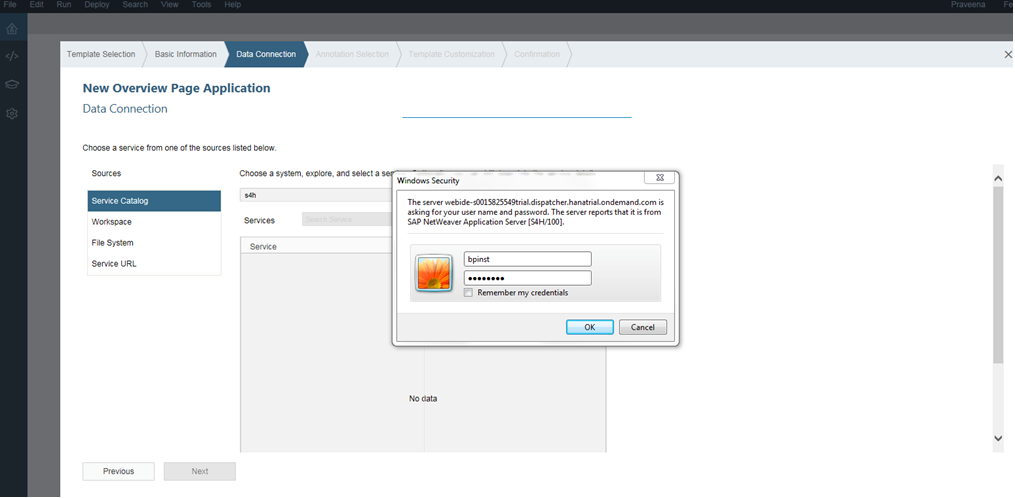






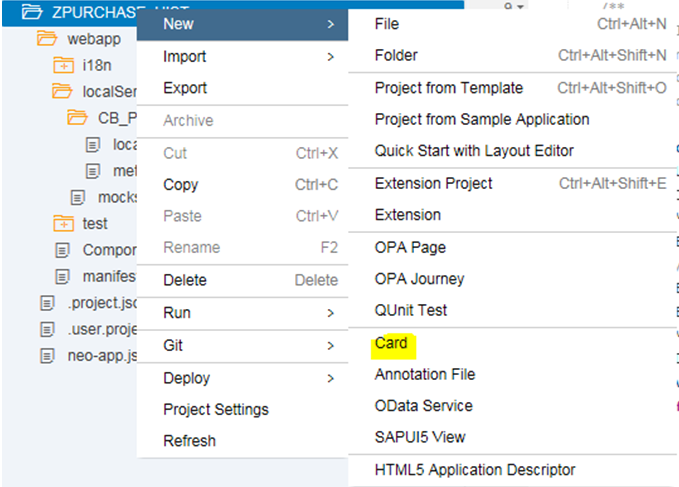


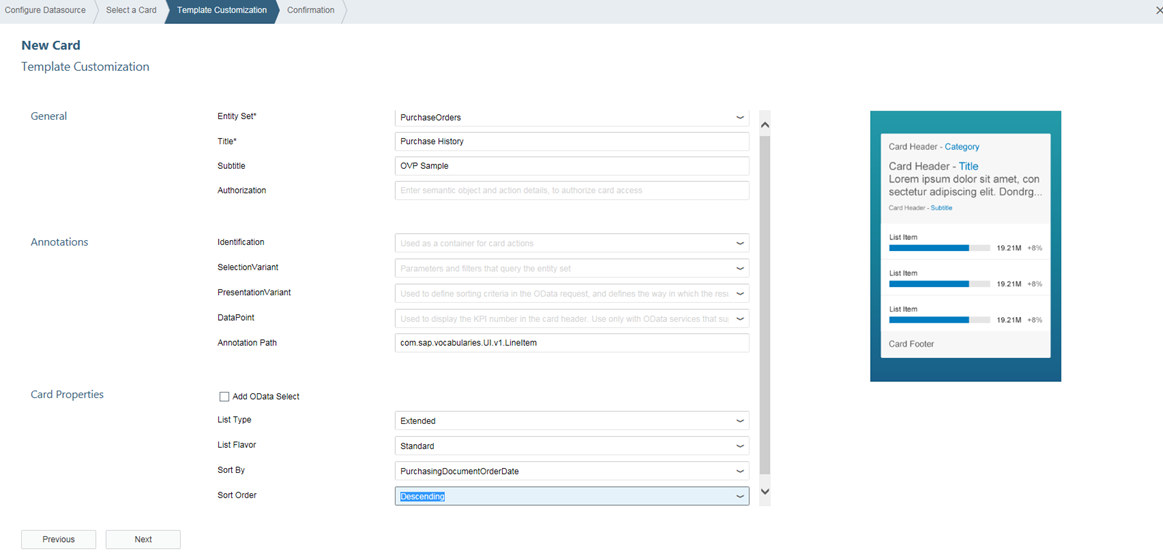


Code Editor:

Descriptor Editor:


13. Save the project and Run Configuration ->SAP Fiori Component on Sandbox->Select required version and save

14. Run with component.js configuration created above.

15. Overview page card displayed as below.

Deploying OVP application to SAPUI5 ABAP repository





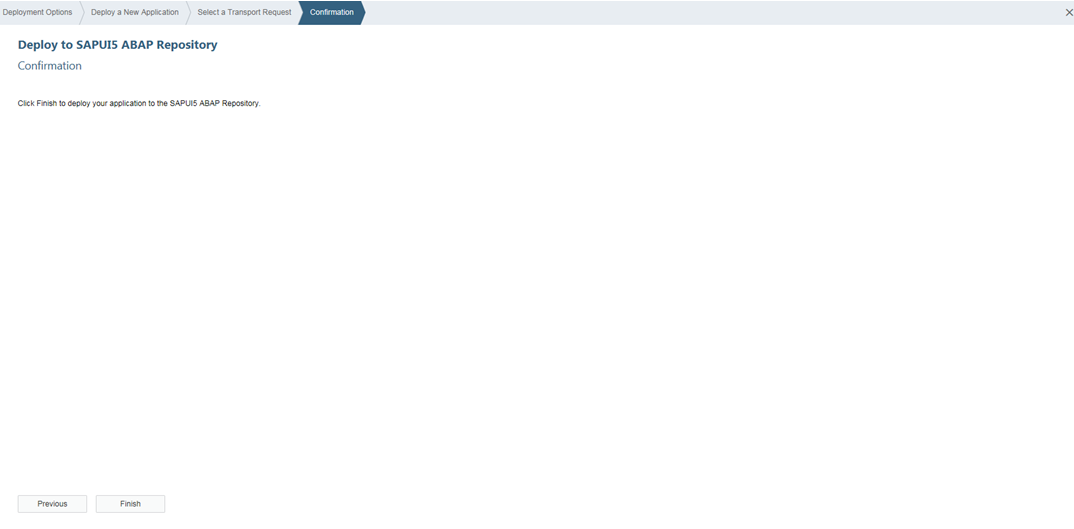
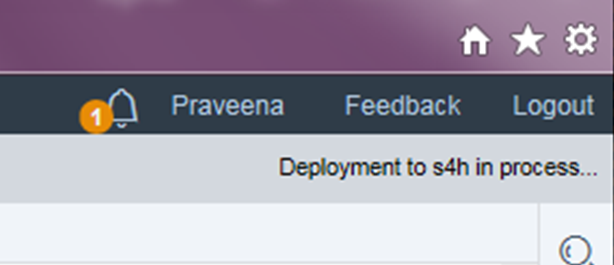





10. Copy the highlighted URL area following with your service name and paste into your application URL in your Launchpad (Now goto step 😎
11. Click the URL Editor.

12. Paste the service URL.

13. Click the Show Advanced Parameters button



https://<server>:<port>/sap/bc/ui5_ui5/sap/arsrvc_upb_admn/main.html

18. Click on add symbol to create a tile to Catalog

19. Create new Tile either Static or Dynamic. At the time of create give own Tile ID and Name. Then, in tiles configuration give Semantic object name and Action.







23. Now assign the roles to users to access this catalogs and groups.
24. Create or Open user roles by using In Menu tab add Fiori tile Group and Catalog by clicking the Transaction button (Small down arrow).

26. Open Fiori Launchpad with the user id and now our tile has appeared.

28. Now the application is deployed successfully and accessible from Fiori Launchpad.
Overview pages provide quick access to vital business information at a glance, in the form of visual, actionable cards.
# Prerequisites # Creating of OVP in WEB IDE # Deploying OVP application to SAPUI5 ABAP repository
Prerequisites:
- Define Data Connection
Below steps are followed to define data connection to backend system.
- Install HANA Cloud Connector
- Configure HANA Cloud Connector
- Add mappings with Real Systems
- Connecting to Remote System from Web IDE
- Install HANA Cloud connector, SAP JVM on your local machine
Download HANA CC from https://tools.hana.ondemand.com/#cloud

- Configure HANA Cloud connector
Open https://localhost:8443
If you get the following error, click on Advanced. This error comes because you don’t have yet any valid certificate for this localhost server

Click on Proceed to localhost (unsafe)

Enter these credentials and click on Login
- User Name: Administrator
- Password: manage
Choose Master as the installation type since this is your first time you are installing the product and this is the only SAP HANA Cloud Connector in your system. Click on Apply

The first time you log in, you need to change the password. Do it and click on Save

Provide the following initial configuration and click on Apply.



- Add Mappings with the real systems.
Go to Cloud to On-Premise-> Access Control
Create Virtual host for internal host vhcals4hci.dummy.nodomain:44300 and HTTPS protocol

Add resources (services)

Status of virtual host and resources should be green

- Connecting to Remote System from Web IDE
From the HANA Cloud cockpit click on the left side on the link Destinations

Click on New Destination

Enter the following parameters

*the URL is not really the address of the real server, but it’s just the name of a virtual server.
Add the following new additional parameters and click on Save

- Enable OVP Plugin
SAP HANA ON DEMAND trial - > Settings - > Plugins

- Create ODATA service SEGW









Service -> maintain -> gateway client

Creation of OVP in Web IDE
- SAP HANA ON DEMAND trial - > Services - > Web IDE - > Open New project from Template

- Select Overview Page Application category

- Provide Project name

- Select service catalog and choose system and service defined in WEB IDE destination


- Select annotation file from local desktop file system


- Sample Annotation File to list Purchase Order List


- Click Finish
- Project ZPURCHASE_HIST will be created and available in workspace.

- Add cards of type List to project





- Open manifest.json file to change annotation url either from descriptor view or code view

- change local uri and uri as below with the exact path of annotation file under project in workspace.
Code Editor:

Descriptor Editor:

- Add #qualifier name (“#PurchaseOrders”) to the annotation path as below in manifest.json file

13. Save the project and Run Configuration ->SAP Fiori Component on Sandbox->Select required version and save


14. Run with component.js configuration created above.

15. Overview page card displayed as below.

Deploying OVP application to SAPUI5 ABAP repository
- Change to required SAPUI5 version from project settings as below and save

- Right Click Project -> Deploy -> Deploy to SAPUI5 ABAP Repository

- Select System to be deployed





- Wait for the successful feedback. Click on You have successfully deployed your app to the ABAP

- To test the application at ABAP system successfully deployed
- Goto SAP Logon and Login to ABAP system.
- TCODE SE80, Click on Repository Browser.
- Choose BSP Application and enter the uploaded application name first letters ( ZPURCHASE_HIST)
- The system will show our application, double click on it

- Create New Launchpad from Give Role, Instance and Description

- Click the New Application

- Enter Link Text. Follow all the places same name to avoid name mismatch. I recommended to follow same BSP file name in all the places. Select application type as “URL”

- Copy url from manifest.json “/sap/bc/ui5_ui5/sap/zpurchase_hist

10. Copy the highlighted URL area following with your service name and paste into your application URL in your Launchpad (Now goto step 😎
11. Click the URL Editor.

12. Paste the service URL.

13. Click the Show Advanced Parameters button

- Enter Application Alias Name (Any name you can fallow) and Additional Information as SAPUI5.Component=ZPURCHASE_HIST. Then save your Lauchpad

- Create Semantic Object by using /UI2/SEMOBJ.Enter Custom Semantic object, Semantic Object name and description and Save.

- The launchpad designer can be launched with the following URL:
https://<server>:<port>/sap/bc/ui5_ui5/sap/arsrvc_upb_admn/main.html

- We can create new catalog or use existing one. In this case using SAP_TC_Common existing catalog to create tile

18. Click on add symbol to create a tile to Catalog

19. Create new Tile either Static or Dynamic. At the time of create give own Tile ID and Name. Then, in tiles configuration give Semantic object name and Action.


- In Target Mapping configuration(Intent) give your semantic object name and Action. (Note: Tile config and Target Mapping config Action should be same) and save.


- Create Groups with own Group ID and text. Once created, Add tile.


- Select your Tile and check the checkbox to enable

23. Now assign the roles to users to access this catalogs and groups.
24. Create or Open user roles by using In Menu tab add Fiori tile Group and Catalog by clicking the Transaction button (Small down arrow).

- Give Tile ID and Group ID Created in step 20 and 21, Give User ID in user tab and save.
26. Open Fiori Launchpad with the user id and now our tile has appeared.

- Click on Tile and redirected into our application.
28. Now the application is deployed successfully and accessible from Fiori Launchpad.
- SAP Managed Tags:
- SAP Fiori,
- SAP Business Technology Platform
18 Comments
You must be a registered user to add a comment. If you've already registered, sign in. Otherwise, register and sign in.
Labels in this area
-
"automatische backups"
1 -
"regelmäßige sicherung"
1 -
"TypeScript" "Development" "FeedBack"
1 -
505 Technology Updates 53
1 -
ABAP
14 -
ABAP API
1 -
ABAP CDS Views
2 -
ABAP CDS Views - BW Extraction
1 -
ABAP CDS Views - CDC (Change Data Capture)
1 -
ABAP class
2 -
ABAP Cloud
2 -
ABAP Development
5 -
ABAP in Eclipse
1 -
ABAP Platform Trial
1 -
ABAP Programming
2 -
abap technical
1 -
absl
2 -
access data from SAP Datasphere directly from Snowflake
1 -
Access data from SAP datasphere to Qliksense
1 -
Accrual
1 -
action
1 -
adapter modules
1 -
Addon
1 -
Adobe Document Services
1 -
ADS
1 -
ADS Config
1 -
ADS with ABAP
1 -
ADS with Java
1 -
ADT
2 -
Advance Shipping and Receiving
1 -
Advanced Event Mesh
3 -
AEM
1 -
AI
7 -
AI Launchpad
1 -
AI Projects
1 -
AIML
9 -
Alert in Sap analytical cloud
1 -
Amazon S3
1 -
Analytical Dataset
1 -
Analytical Model
1 -
Analytics
1 -
Analyze Workload Data
1 -
annotations
1 -
API
1 -
API and Integration
3 -
API Call
2 -
Application Architecture
1 -
Application Development
5 -
Application Development for SAP HANA Cloud
3 -
Applications and Business Processes (AP)
1 -
Artificial Intelligence
1 -
Artificial Intelligence (AI)
5 -
Artificial Intelligence (AI) 1 Business Trends 363 Business Trends 8 Digital Transformation with Cloud ERP (DT) 1 Event Information 462 Event Information 15 Expert Insights 114 Expert Insights 76 Life at SAP 418 Life at SAP 1 Product Updates 4
1 -
Artificial Intelligence (AI) blockchain Data & Analytics
1 -
Artificial Intelligence (AI) blockchain Data & Analytics Intelligent Enterprise
1 -
Artificial Intelligence (AI) blockchain Data & Analytics Intelligent Enterprise Oil Gas IoT Exploration Production
1 -
Artificial Intelligence (AI) blockchain Data & Analytics Intelligent Enterprise sustainability responsibility esg social compliance cybersecurity risk
1 -
ASE
1 -
ASR
2 -
ASUG
1 -
Attachments
1 -
Authorisations
1 -
Automating Processes
1 -
Automation
2 -
aws
2 -
Azure
1 -
Azure AI Studio
1 -
B2B Integration
1 -
Backorder Processing
1 -
Backup
1 -
Backup and Recovery
1 -
Backup schedule
1 -
BADI_MATERIAL_CHECK error message
1 -
Bank
1 -
BAS
1 -
basis
2 -
Basis Monitoring & Tcodes with Key notes
2 -
Batch Management
1 -
BDC
1 -
Best Practice
1 -
bitcoin
1 -
Blockchain
3 -
bodl
1 -
BOP in aATP
1 -
BOP Segments
1 -
BOP Strategies
1 -
BOP Variant
1 -
BPC
1 -
BPC LIVE
1 -
BTP
12 -
BTP Destination
2 -
Business AI
1 -
Business and IT Integration
1 -
Business application stu
1 -
Business Application Studio
1 -
Business Architecture
1 -
Business Communication Services
1 -
Business Continuity
1 -
Business Data Fabric
3 -
Business Partner
12 -
Business Partner Master Data
10 -
Business Technology Platform
2 -
Business Trends
1 -
CA
1 -
calculation view
1 -
CAP
3 -
Capgemini
1 -
CAPM
1 -
Catalyst for Efficiency: Revolutionizing SAP Integration Suite with Artificial Intelligence (AI) and
1 -
CCMS
2 -
CDQ
12 -
CDS
2 -
Cental Finance
1 -
Certificates
1 -
CFL
1 -
Change Management
1 -
chatbot
1 -
chatgpt
3 -
CL_SALV_TABLE
2 -
Class Runner
1 -
Classrunner
1 -
Cloud ALM Monitoring
1 -
Cloud ALM Operations
1 -
cloud connector
1 -
Cloud Extensibility
1 -
Cloud Foundry
4 -
Cloud Integration
6 -
Cloud Platform Integration
2 -
cloudalm
1 -
communication
1 -
Compensation Information Management
1 -
Compensation Management
1 -
Compliance
1 -
Compound Employee API
1 -
Configuration
1 -
Connectors
1 -
Consolidation Extension for SAP Analytics Cloud
1 -
Control Indicators.
1 -
Controller-Service-Repository pattern
1 -
Conversion
1 -
Cosine similarity
1 -
cryptocurrency
1 -
CSI
1 -
ctms
1 -
Custom chatbot
3 -
Custom Destination Service
1 -
custom fields
1 -
Customer Experience
1 -
Customer Journey
1 -
Customizing
1 -
cyber security
3 -
Data
1 -
Data & Analytics
1 -
Data Aging
1 -
Data Analytics
2 -
Data and Analytics (DA)
1 -
Data Archiving
1 -
Data Back-up
1 -
Data Governance
5 -
Data Integration
2 -
Data Quality
12 -
Data Quality Management
12 -
Data Synchronization
1 -
data transfer
1 -
Data Unleashed
1 -
Data Value
8 -
database tables
1 -
Datasphere
2 -
datenbanksicherung
1 -
dba cockpit
1 -
dbacockpit
1 -
Debugging
2 -
Delimiting Pay Components
1 -
Delta Integrations
1 -
Destination
3 -
Destination Service
1 -
Developer extensibility
1 -
Developing with SAP Integration Suite
1 -
Devops
1 -
digital transformation
1 -
Documentation
1 -
Dot Product
1 -
DQM
1 -
dump database
1 -
dump transaction
1 -
e-Invoice
1 -
E4H Conversion
1 -
Eclipse ADT ABAP Development Tools
2 -
edoc
1 -
edocument
1 -
ELA
1 -
Embedded Consolidation
1 -
Embedding
1 -
Embeddings
1 -
Employee Central
1 -
Employee Central Payroll
1 -
Employee Central Time Off
1 -
Employee Information
1 -
Employee Rehires
1 -
Enable Now
1 -
Enable now manager
1 -
endpoint
1 -
Enhancement Request
1 -
Enterprise Architecture
1 -
ETL Business Analytics with SAP Signavio
1 -
Euclidean distance
1 -
Event Dates
1 -
Event Driven Architecture
1 -
Event Mesh
2 -
Event Reason
1 -
EventBasedIntegration
1 -
EWM
1 -
EWM Outbound configuration
1 -
EWM-TM-Integration
1 -
Existing Event Changes
1 -
Expand
1 -
Expert
2 -
Expert Insights
1 -
Fiori
14 -
Fiori Elements
2 -
Fiori SAPUI5
12 -
Flask
1 -
Full Stack
8 -
Funds Management
1 -
General
1 -
Generative AI
1 -
Getting Started
1 -
GitHub
8 -
Grants Management
1 -
groovy
1 -
GTP
1 -
HANA
6 -
HANA Cloud
2 -
Hana Cloud Database Integration
2 -
HANA DB
2 -
HANA XS Advanced
1 -
Historical Events
1 -
home labs
1 -
HowTo
1 -
HR Data Management
1 -
html5
8 -
HTML5 Application
1 -
Identity cards validation
1 -
idm
1 -
Implementation
1 -
input parameter
1 -
instant payments
1 -
Integration
3 -
Integration Advisor
1 -
Integration Architecture
1 -
Integration Center
1 -
Integration Suite
1 -
intelligent enterprise
1 -
iot
1 -
Java
1 -
job
1 -
Job Information Changes
1 -
Job-Related Events
1 -
Job_Event_Information
1 -
joule
4 -
Journal Entries
1 -
Just Ask
1 -
Kerberos for ABAP
8 -
Kerberos for JAVA
8 -
KNN
1 -
Launch Wizard
1 -
learning content
2 -
Life at SAP
1 -
lightning
1 -
Linear Regression SAP HANA Cloud
1 -
local tax regulations
1 -
LP
1 -
Machine Learning
2 -
Marketing
1 -
Master Data
3 -
Master Data Management
14 -
Maxdb
2 -
MDG
1 -
MDGM
1 -
MDM
1 -
Message box.
1 -
Messages on RF Device
1 -
Microservices Architecture
1 -
Microsoft Universal Print
1 -
Middleware Solutions
1 -
Migration
5 -
ML Model Development
1 -
Modeling in SAP HANA Cloud
8 -
Monitoring
3 -
MTA
1 -
Multi-Record Scenarios
1 -
Multiple Event Triggers
1 -
Neo
1 -
New Event Creation
1 -
New Feature
1 -
Newcomer
1 -
NodeJS
2 -
ODATA
2 -
OData APIs
1 -
odatav2
1 -
ODATAV4
1 -
ODBC
1 -
ODBC Connection
1 -
Onpremise
1 -
open source
2 -
OpenAI API
1 -
Oracle
1 -
PaPM
1 -
PaPM Dynamic Data Copy through Writer function
1 -
PaPM Remote Call
1 -
PAS-C01
1 -
Pay Component Management
1 -
PGP
1 -
Pickle
1 -
PLANNING ARCHITECTURE
1 -
Popup in Sap analytical cloud
1 -
PostgrSQL
1 -
POSTMAN
1 -
Process Automation
2 -
Product Updates
4 -
PSM
1 -
Public Cloud
1 -
Python
4 -
Qlik
1 -
Qualtrics
1 -
RAP
3 -
RAP BO
2 -
Record Deletion
1 -
Recovery
1 -
recurring payments
1 -
redeply
1 -
Release
1 -
Remote Consumption Model
1 -
Replication Flows
1 -
research
1 -
Resilience
1 -
REST
1 -
REST API
1 -
Retagging Required
1 -
Risk
1 -
Rolling Kernel Switch
1 -
route
1 -
rules
1 -
S4 HANA
1 -
S4 HANA Cloud
1 -
S4 HANA On-Premise
1 -
S4HANA
3 -
S4HANA_OP_2023
2 -
SAC
10 -
SAC PLANNING
9 -
SAP
4 -
SAP ABAP
1 -
SAP Advanced Event Mesh
1 -
SAP AI Core
8 -
SAP AI Launchpad
8 -
SAP Analytic Cloud Compass
1 -
Sap Analytical Cloud
1 -
SAP Analytics Cloud
4 -
SAP Analytics Cloud for Consolidation
2 -
SAP Analytics Cloud Story
1 -
SAP analytics clouds
1 -
SAP BAS
1 -
SAP Basis
6 -
SAP BODS
1 -
SAP BODS certification.
1 -
SAP BTP
21 -
SAP BTP Build Work Zone
2 -
SAP BTP Cloud Foundry
6 -
SAP BTP Costing
1 -
SAP BTP CTMS
1 -
SAP BTP Innovation
1 -
SAP BTP Migration Tool
1 -
SAP BTP SDK IOS
1 -
SAP Build
11 -
SAP Build App
1 -
SAP Build apps
1 -
SAP Build CodeJam
1 -
SAP Build Process Automation
3 -
SAP Build work zone
10 -
SAP Business Objects Platform
1 -
SAP Business Technology
2 -
SAP Business Technology Platform (XP)
1 -
sap bw
1 -
SAP CAP
2 -
SAP CDC
1 -
SAP CDP
1 -
SAP CDS VIEW
1 -
SAP Certification
1 -
SAP Cloud ALM
4 -
SAP Cloud Application Programming Model
1 -
SAP Cloud Integration for Data Services
1 -
SAP cloud platform
8 -
SAP Companion
1 -
SAP CPI
3 -
SAP CPI (Cloud Platform Integration)
2 -
SAP CPI Discover tab
1 -
sap credential store
1 -
SAP Customer Data Cloud
1 -
SAP Customer Data Platform
1 -
SAP Data Intelligence
1 -
SAP Data Migration in Retail Industry
1 -
SAP Data Services
1 -
SAP DATABASE
1 -
SAP Dataspher to Non SAP BI tools
1 -
SAP Datasphere
9 -
SAP DRC
1 -
SAP EWM
1 -
SAP Fiori
2 -
SAP Fiori App Embedding
1 -
Sap Fiori Extension Project Using BAS
1 -
SAP GRC
1 -
SAP HANA
1 -
SAP HCM (Human Capital Management)
1 -
SAP HR Solutions
1 -
SAP IDM
1 -
SAP Integration Suite
9 -
SAP Integrations
4 -
SAP iRPA
2 -
SAP Learning Class
1 -
SAP Learning Hub
1 -
SAP Odata
2 -
SAP on Azure
1 -
SAP PartnerEdge
1 -
sap partners
1 -
SAP Password Reset
1 -
SAP PO Migration
1 -
SAP Prepackaged Content
1 -
SAP Process Automation
2 -
SAP Process Integration
2 -
SAP Process Orchestration
1 -
SAP S4HANA
2 -
SAP S4HANA Cloud
1 -
SAP S4HANA Cloud for Finance
1 -
SAP S4HANA Cloud private edition
1 -
SAP Sandbox
1 -
SAP STMS
1 -
SAP successfactors
3 -
SAP SuccessFactors HXM Core
1 -
SAP Time
1 -
SAP TM
2 -
SAP Trading Partner Management
1 -
SAP UI5
1 -
SAP Upgrade
1 -
SAP Utilities
1 -
SAP-GUI
8 -
SAP_COM_0276
1 -
SAPBTP
1 -
SAPCPI
1 -
SAPEWM
1 -
sapmentors
1 -
saponaws
2 -
SAPS4HANA
1 -
SAPUI5
4 -
schedule
1 -
Secure Login Client Setup
8 -
security
9 -
Selenium Testing
1 -
SEN
1 -
SEN Manager
1 -
service
1 -
SET_CELL_TYPE
1 -
SET_CELL_TYPE_COLUMN
1 -
SFTP scenario
2 -
Simplex
1 -
Single Sign On
8 -
Singlesource
1 -
SKLearn
1 -
soap
1 -
Software Development
1 -
SOLMAN
1 -
solman 7.2
2 -
Solution Manager
3 -
sp_dumpdb
1 -
sp_dumptrans
1 -
SQL
1 -
sql script
1 -
SSL
8 -
SSO
8 -
Substring function
1 -
SuccessFactors
1 -
SuccessFactors Platform
1 -
SuccessFactors Time Tracking
1 -
Sybase
1 -
system copy method
1 -
System owner
1 -
Table splitting
1 -
Tax Integration
1 -
Technical article
1 -
Technical articles
1 -
Technology Updates
1 -
Technology Updates
1 -
Technology_Updates
1 -
terraform
1 -
Threats
1 -
Time Collectors
1 -
Time Off
2 -
Time Sheet
1 -
Time Sheet SAP SuccessFactors Time Tracking
1 -
Tips and tricks
2 -
toggle button
1 -
Tools
1 -
Trainings & Certifications
1 -
Transport in SAP BODS
1 -
Transport Management
1 -
TypeScript
2 -
ui designer
1 -
unbind
1 -
Unified Customer Profile
1 -
UPB
1 -
Use of Parameters for Data Copy in PaPM
1 -
User Unlock
1 -
VA02
1 -
Validations
1 -
Vector Database
2 -
Vector Engine
1 -
Visual Studio Code
1 -
VSCode
1 -
Web SDK
1 -
work zone
1 -
workload
1 -
xsa
1 -
XSA Refresh
1
- « Previous
- Next »
Related Content
- How to use AI services to translate Picklists in SAP SuccessFactors - An example in Technology Blogs by SAP
- Improvising Time Management in SAP S/4HANA Cloud: A Co-Innovation Solution in Technology Blogs by SAP
- Easy way to automate and configure the setup of a BTP account and Cloud Foundry using Terraform. in Technology Blogs by Members
- Accelerate Business Process Development with SAP Build Process Automation Pre-Built Content in Technology Blogs by SAP
- Mistral gagnant. Mistral AI and SAP Kyma serverless. in Technology Blogs by SAP
Top kudoed authors
| User | Count |
|---|---|
| 12 | |
| 12 | |
| 7 | |
| 5 | |
| 5 | |
| 4 | |
| 4 | |
| 3 | |
| 3 | |
| 3 |